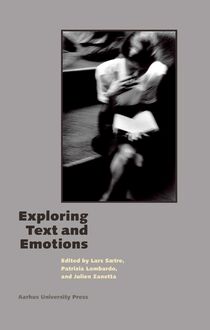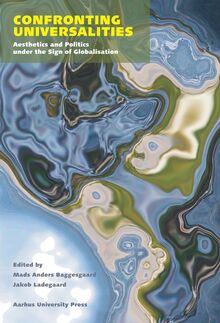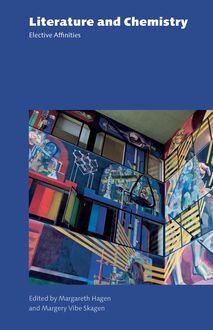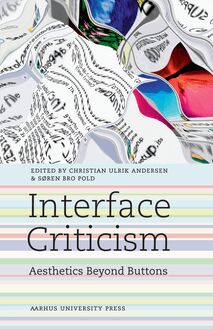-
 Univers
Univers
-
 Ebooks
Ebooks
-
 Livres audio
Livres audio
-
 Presse
Presse
-
 Podcasts
Podcasts
-
 BD
BD
-
 Documents
Documents
-
- Cours
- Révisions
- Ressources pédagogiques
- Sciences de l’éducation
- Manuels scolaires
- Langues
- Travaux de classe
- Annales de BEP
- Etudes supérieures
- Maternelle et primaire
- Fiches de lecture
- Orientation scolaire
- Méthodologie
- Corrigés de devoir
- Annales d’examens et concours
- Annales du bac
- Annales du brevet
- Rapports de stage
La lecture à portée de main
Vous pourrez modifier la taille du texte de cet ouvrage
Découvre YouScribe en t'inscrivant gratuitement
Je m'inscrisDécouvre YouScribe en t'inscrivant gratuitement
Je m'inscrisEn savoir plus
Vous pourrez modifier la taille du texte de cet ouvrage
En savoir plus

Description
Fifteen essays on various art works analyse how modern fiction, drama, theatre, poetry and film, as well as Greek tragedy, succeed in both expressing and suggesting a vast and nuanced array of emotions while provoking affective responses in readers and spectators. The volume focuses on the exemplary way in which literature and the arts act upon our minds and have a strong impact on our understanding of aesthetic, political and moral values, challenging, shaping and transforming culture. The volume also intends to show how seminal writers and works have anticipated contemporary theories of emotions and can contribute to their growth.
Linking formal, aesthetic and cultural-studies approaches, and combining the latest developments in the affective sciences with the close reading of texts, the volume puts forward a new direction for the study of literature, arts, media and culture.
Sujets
Informations
| Publié par | Aarhus University Press |
| Date de parution | 21 février 2014 |
| Nombre de lectures | 0 |
| EAN13 | 9788771245677 |
| Langue | English |
Informations légales : prix de location à la page 0,1550€. Cette information est donnée uniquement à titre indicatif conformément à la législation en vigueur.
Extrait
Edited by Lars S tre, Patrizia Lombardo, and Julien Zanetta
Exploring Text and Emotions
In memory of Atle Kittang
Text and Emotions
Lars S tre, UNIVERSITY OF BERGEN ; Patrizia Lombardo, UNIVERSITY OF GENEVA ; Julien Zanetta, UNIVERSITY OF GENEVA
The present volume is the second publication generated by the Project Text, Action and Space . 1 The first volume, Exploring Textual Action (2010), focused on textual action and performativity and their spatial implications. This volume aspires to contribute to the investigation of emotions and their interaction with the dynamics of textuality and spatiality, showing the essential role of literature and the arts in the understanding of affective phenomena, such as emotions, feelings, sentiments, dispositions and moods. All the articles are explorative in the sense that they work with concrete texts and other art works. As in the first volume, those with greater emphasis on the conceptual aspects are united in the section Elaborations , while the contributions with a stronger analytical perspective can be found under the heading Explorations .
Works in literature and in the arts are texts in the general sense of the term, that is to say readable and interpretable objects. They represent, express or suggest affective phenomena either via direct description - verbal or visual - or in an indirect way, by allusions or effects of various types, such as the treatment of space, time, angles of vision, perspectives, and stylistic means. The novel, poetry, drama, painting and film offer what can be called a rich account of emotions. In fact, characters and narrators as well as landscapes and objects show emotions in the acute manifestation of an episode or an action (internal or external) as much as in the development of affects through time. The arts also operate upon our minds or, more precisely, they display what we in Exploring Textual Action established as performative power, via performative language indeed, but also thanks to the emotion or the emotions they suscitate in us. Emotions have what psychologists call action tendency, which means that they solicit our response either in the external or in the internal world, in gestures or in thoughts, in the body or in the mind, or more precisely in the amalgam that is the body and the mind. If I am afraid, for example, my heart will beat and I will try to protect myself from the danger I perceive, or perhaps I will turn completely frozen by it. If I feel nostalgia for something, I will react either by being sad for my loss, or by contemplating more joyful aspects of life. If I feel rage for an abuse, I may be drawn to political consciousness or commitment.
We are convinced that it is important today that criticism reflects on the affective dimension of literature and the arts. The consequences of art s affective dimension are of great interest both for ethics and aesthetics; actually, they can show the interconnection of the two spheres and therefore also the cultural interaction between them. Emotions are in fact tied to human values, and values to emotions. How could we, for instance, feel indignation for a social or moral injustice if we were not to value justice? In the arts there is interplay between the emotions they represent, express and suggest, and those triggered by them in us, the readers or spectators. The arts offer axiological knowledge, a type of cognition linked to two kinds of values: those circulating in the world - moral and political values - and those corresponding to aesthetic categories, such as the tragic, comic, sublime, beautiful, ugly, kitsch, etc. The aesthetic experience consists of movements in both directions between the two types and levels of emotions just described.
Since the 1970s, literary and art theories have been dominated first by formalist and then by cultural-studies approaches often disregarding the importance of aesthetic values and the ethical and cognitive dimensions of literature and the arts. In the last decades, the most refined structuralist, poststructuralist and postmodern literary critics have concentrated their analyses on the problem of meaning and on the construction of discourse. Paradoxically, they have avoided confronting what is fundamental in literature and in art - in their various traditional and new forms or media: both their intrinsic value as literature or art, and their ability to represent, express and foster human sentiments, actions and beliefs, as well as their impact on us. This avoidance should in part be understood as a healthy rejection of the old literary psychology and the old literary history that explained the meaning and effect of art works by the biography of the author. The poststructuralist and postmodern mistrust of the very idea and the term of mimetic representation indicated a refusal of the passivity implicit in the term: works of art cannot be reduced to the mere mirroring of the world.
In the study of affectivity, Freudian and Lacanian psychoanalytical approaches have stressed instincts and drives, and put a particular emphasis on a few emotional states: anguish, depression, melancholia and mourning. However, our affective life is rich and multifaceted, and - as we know from the simplest experiences of readers and spectators and from numerous works of art - there are many more emotions than those canonical psychoanalytic affective states. Often the interior space has been emphasised at the expense of the relation between exterior and interior spaces; in order to avoid this drawback we pay attention in this volume, as we did in the previous one, to the way in which space is treated in the texts we examine. The role of perception cannot be dismissed, since our senses are immediately connected to our mind, to the body-mind mix already mentioned. Literature and the arts express essential questions for human beings and their interactions: affects are at stake in every aspect of personal and social life, and our study of several different texts includes their emotional framework and their effect upon us.
Therefore, after the so-called linguistic turn, the present research aims at integrating, within literary and arts studies, the affective turn that has influenced several disciplines since the 1980s. In fact, many disciplines - from economics to political science, philosophy, psychology, history, law, biology and the neurosciences - have taken an affective turn. The study of emotions which seemed experimentally impossible for disciplines like psychology and the cognitive sciences has now entered their agenda. The great variety of affective phenomena has been the object of many definitions, investigations, hypotheses and tests. For instance, brain-imaging experiments are now commonly undertaken. Topics which have always been common in novels, dramas and films - love, ambition, jealousy, rage, regret, remorse, resentment, trust, nostalgia, disgust and fear - have come to figure in many fields of knowledge. Literary and art criticism should not leave to the experimental sciences the prerogative of theorising those topics. Indeed, literary research can enhance the study of emotions showing that there are writers and artists who, consciously or unconsciously, have outlined theories of emotions with a more compelling grasp of their complexities than the more conceptually ambitious sciences. Writers can be considered as true thinkers of emotions in their theoretical, essayistic and narrative works alike - such as Honor de Balzac, Stendhal, William Hazlitt, Jane Austen, Flaubert, Marcel Proust, and Robert Musil. An important target of this volume is to highlight the theoretical impact of writers and their experiments with the complexity of emotions.
***
The new direction of research into the emotions in the late 1970s and in the 1980s was initiated by some seminal works. We will only list a few, indicating the main trends, but the contributions to this volume will include a more extensive range of works. Albert Hirschman, a true pioneer, in his The Passions and the Interests: Political Arguments for Capitalism before its Triumph (1977), broke with the habits of political science and economics by considering the role of human passions in the making of the modern market economy. Jon Elster s Sour Grapes: Studies in the Subversion of Rationality (1983) showed that the presence of emotions in politics and economics had too often been neglected: he used examples taken from Stendhal, and later, in his Alchemies of the Mind. Rationality and the Emotions (1999), he took examples from 17th-century French moralists. In 1988 the economist Robert Frank, in his Passions within Reason. The Strategic Role of Emotions , challenged the quantitative and purely cognitivist strand of decision theory: his book launched the provocative thesis that emotions are essential in decision-making, and that often decisions which seem irrational manage to combine both self-interest and social cooperation.
The contribution of analytical philosophy to the study of emotions has been crucial. Just to mention two references: William Lyons, for example, investigated in his Emotion (1980) the nature of emotions and the evaluative process inherent in them. He took love as a model, with its many manifestations, and not the basic emotion of fear, typically used as a model in psychology. Ronald de Sousa, in his groundbreaking book The Rationality of Emotion (1987), discussed the interplay between reason and affect, showing that emotions have motives, cognitive substance and formal objects, a perspective which later, and with a historical concern, was developed by Martha Nussbaum in Upheavals of Thought. The Intelligence of Emotions (2001).
The historical awareness is crucial. In Western thought, the problem of affects goes back to ancient philosophy. The discrepant positions of Plato and Aristotle paved th
-
 Univers
Univers
-
 Ebooks
Ebooks
-
 Livres audio
Livres audio
-
 Presse
Presse
-
 Podcasts
Podcasts
-
 BD
BD
-
 Documents
Documents
-
Jeunesse
-
Littérature
-
Ressources professionnelles
-
Santé et bien-être
-
Savoirs
-
Education
-
Loisirs et hobbies
-
Art, musique et cinéma
-
Actualité et débat de société
-
Jeunesse
-
Littérature
-
Ressources professionnelles
-
Santé et bien-être
-
Savoirs
-
Education
-
Loisirs et hobbies
-
Art, musique et cinéma
-
Actualité et débat de société
-
Actualités
-
Lifestyle
-
Presse jeunesse
-
Presse professionnelle
-
Pratique
-
Presse sportive
-
Presse internationale
-
Culture & Médias
-
Action et Aventures
-
Science-fiction et Fantasy
-
Société
-
Jeunesse
-
Littérature
-
Ressources professionnelles
-
Santé et bien-être
-
Savoirs
-
Education
-
Loisirs et hobbies
-
Art, musique et cinéma
-
Actualité et débat de société
- Cours
- Révisions
- Ressources pédagogiques
- Sciences de l’éducation
- Manuels scolaires
- Langues
- Travaux de classe
- Annales de BEP
- Etudes supérieures
- Maternelle et primaire
- Fiches de lecture
- Orientation scolaire
- Méthodologie
- Corrigés de devoir
- Annales d’examens et concours
- Annales du bac
- Annales du brevet
- Rapports de stage









